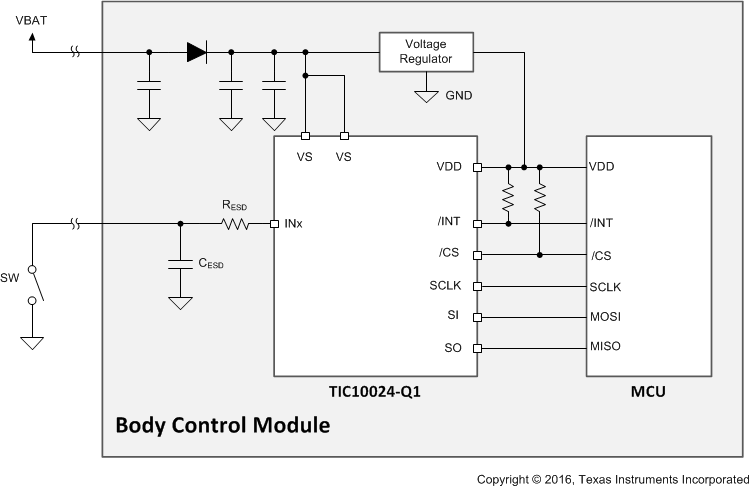SCPS268A September 2017 – February 2022 TIC10024-Q1
PRODUCTION DATA
- 1 Features
- 2 Applications
- 3 Description
- 4 Revision History
- 5 Pin Configuration and Functions
- 6 Specifications
- 7 Parameter Measurement Information
-
8 Detailed Description
- 8.1 Overview
- 8.2 Functional Block Diagram
- 8.3
Feature Description
- 8.3.1 VS Pin
- 8.3.2 VDD Pin
- 8.3.3 Device Initialization
- 8.3.4 Device Trigger
- 8.3.5 Device Reset
- 8.3.6 VS Under-Voltage (UV) Condition
- 8.3.7 VS Over-Voltage (OV) Condition
- 8.3.8 Switch Inputs Settings
- 8.3.9 Interrupt Generation and INT Assertion
- 8.3.10 Temperature Monitor
- 8.3.11 Parity Check And Parity Generation
- 8.3.12 Cyclic Redundancy Check (CRC)
- 8.4 Device Functional Modes
- 9 Programming
- 10Application and Implementation
- 11Power Supply Recommendations
- 12Layout
- 13Device and Documentation Support
- 14Mechanical, Packaging, and Orderable Information
Package Options
Mechanical Data (Package|Pins)
- DCP|38
Thermal pad, mechanical data (Package|Pins)
- DCP|38
Orderable Information
10.2 Digital Switch Detection in Automotive Body Control Module
The body control module (BCM) is an electronic control unit responsible for monitoring and controlling various electronic accessories in a vehicle body. Detection of various mechanical switches status in a vehicle is one important task handled by the BCM. Most switches inside the BCM are digital in nature, meaning they have either an ON or an OFF state. The TIC10024-Q1 can detect up to 24 digital switches. The following application diagram depicts how the TIC10024-Q1 is used in a BCM to detect an external digital switch and a detailed design example is shown in the following sections.
 Figure 10-1 Using TIC10024-Q1 to Monitor a Digital Switch in Body Control Module Application
Figure 10-1 Using TIC10024-Q1 to Monitor a Digital Switch in Body Control Module Application